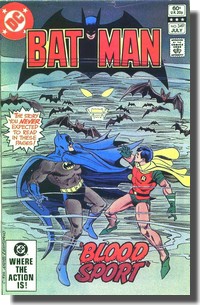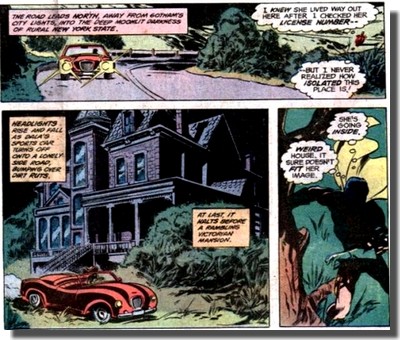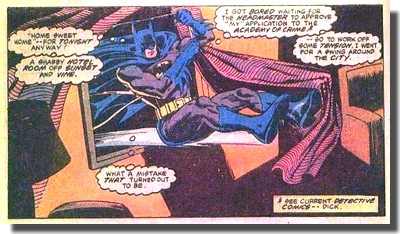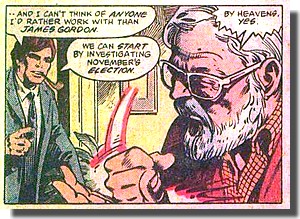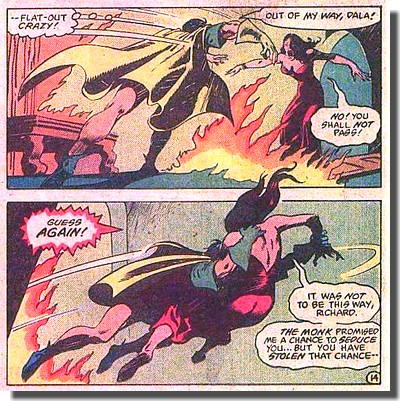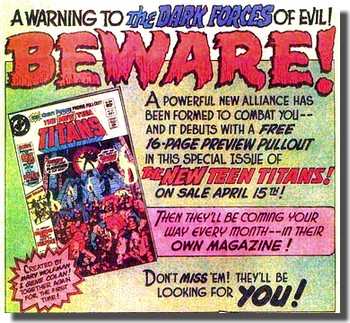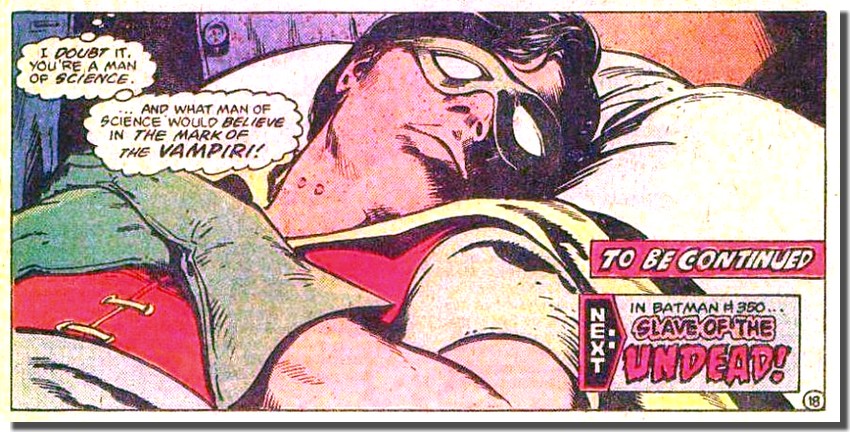 |
||||
(PART ONE) BATMAN
#349 (JULY 1982) |
||||
|
||||
|
||||
| This modus operandi effectively created a fortnightly Batman book, with Batman on sale on the second Wednesday of a month and Detective Comics on the fourth. Whilst this running in parallel did not ultimately require readers to buy both books (there would usually be a brief recap of the events which took place in the preceding issue of the other title), reading only one of the two titles naturally made the storyline feel slightly "jumpy" at times. | ||||
|
||||
|
||||
| Meanwhile,
somewhere in upstate New York, Robin finds himself bound
and gagged in the presence of precisely the girl he was
worried about: Dala. She makess a few mysterious remarks
to her captive admirer and leaves him because, as she
puts it, there are many preparations to be made and her
brother will be getting impatient. Robin's thoughts are
in a spin as he can't get anything he has witnessed
during the past minutes to add up to much sense, and the
fact that Dala is acting as though they were both part of
an old Vincent Price is movie is none too comforting as
Dick is beginning to get scared and realizes that Dala,
obviously, never cared for him in any way... At the same time, but two hundred odd miles away in Boston, Alfred - unbeknownst to anybody else - is seeking the services of Christopher Chance, a.k.a. The Human Target, who impersonates people who are in fear of their lives. Telling Chance that his employer Bruce Wayne is in peril because of business interests but must not know about all of this due to his heart condition, Alfred arouses the Human Target's interest - not the least because he is sure that he is far from being told the whole truth. Chance agrees to do the job, and Alfred leaves for Gotham feeling, feeling reassured that this setup will counteract any media coverage on Bruce Wayne being the Batman. |
||||
|
||||
| Meanwhile, Robin manages to free himself of the ropes which tie him to a chair, but in doing so knocks over a gas lamp which causes a fire to spread rapidly. Just about to seek a way out of the flames and the mansion, he is all of a sudden faced with Dala and an otherworldly figure clad in the crimson robe of a monk, and both appear to have just sprung out of hell itself with burning red eyes and vampire fangs... | ||||
|
||||
REVIEW & ANALYSIS Aligning Detective Comics and Batman for the second round of story crossovers running into and out of both titles, writer Gerry Conway and editor Dick Giordano now expanded the formula. Not only would the various subplots - which were mostly tied to individual characters - continue over several issues of both titles, but the mainframe story itself would now carry on and not simply kick off in Batman and then conclude in that same month's Detective Comics. As for the first villain for this extended crossover scheme, Conway and Giordano visited the Batman's past. Following up on Doctor Death, who was the Batman's first true villain back in 1939 and had been reintroduced to start the 1982 crossover cycle, the next in line was The Monk, who had first appeared in Detective Comics #31 and #32, the Darknight Detective's first multi-issue adventure. Portrayed by Gardner Fox in 1939 as a vampire from Hungary, he was also Batman's first supernatural villain, and whether by coincidence or not, this constellation was nothing short of perfect for DC at a time when they newly had horror's foremost artist on their payroll: Gene Colan. Colan had been experiencing rough and increasingly hard working relations with Jim Shooter, who had become editor-in-chief at Marvel in 1978, and Colan finally went across the road to work at DC in 1981. His last published work for Marvel was Avengers #211 for September 1981, to which his first work for DC joined up neatly with Batman #340 for October 1981 - reuniting him with his former work colleagues at Marvel, Roy Thomas and Gerry Conway. |
||||
|
||||
DC was
digging heavily into Gene Colan's reputation, and whilst
the sudden surge in his output of shadowy gothic artwork
could have been perceived as slightly forced, this was
quintessentially something which Colan not only excelled
at, but which he actually enjoyed.
As for Batman, writer Gerry Conway decided that if Batman was to have a supernatural adversary then he would go all the way - and have the supernatural inflict some real damage on the Dynamic Duo. Due to the ingenious setup by Conway, the vampire story starts out in Batman #349 essentially as a tale involving Robin only. Whilst the previous story crossover between Batman and Detective Comics were sequential, i.e. part one followed by part two, the two titles were now written in parallel. As a result, Detective Comics was now focused on the West Coast (and therefore Batman on the trail of the Academy of Crime), whilst Batman was showing readers what was happening at the same time on the East Coast without the Batman being present. Batman #349 also illustrates how Conway moved from overall plot to specific storyline; the firsts elements for the vampire saga which was now to unfold had been inserted back in Detective Comics #511 (February 1982) when Dick Grayson enrolled at Gotham University and first met Dala on campus - which, as readers now learn, was far from being a coincidence. All of the aforementioned elements combine to make Batman #349 an extraordinary comic book. Gerry Conway is in full and easy command of plot and story, and Gene Colan's pencils add the perfect visual atmosphere. However, in appraising Batman #349, readers had to - and still need to do so today - find out whether or not they felt that the world of Batman and that of vampires were compatible. Whilst Batman had, of course, often moved outside of common reality during the course of his publication career (not the least, of course, when he met the Monk in 1939), it had been precisely this element which Dennis O'Neil and Neal Adams had worked out of the post-camp and post-sci/fi world of Batman, making the Darknight Detective more believable by asking readers to stretch their imagination, rather than needing to suspend their belief all too often. |
||||
|
||||
| But then Gerry Conway did not really digress from those defining lines established by O'Neil and Adams and firmly rooted the vampire theme in down to earth reality, and the overall reactions from readers acknowledged and appreciated this in 1982. Conway and Colan had succeeded in rolling out a stark and chilling tale by avoiding the pitfalls of sillyness. | ||||
BIBLIOGRAPHY DLUGOS Jenn (2002) Gene Colan Interview, available on-line and accessed 9 June 2008 at www.classic-horror.com/newsreel/gene_colan_interview SIUNTRES John (2005) "Gene Colan Interview", in Word Balloon: The Comic Creator's Interview Show, available online at wordballoon.libsyn.com THOMAS Roy (2000) "So you want a Job eh? The Gene Colan Interview", Alter Ego 6 (vol. 3) |
||||
|

